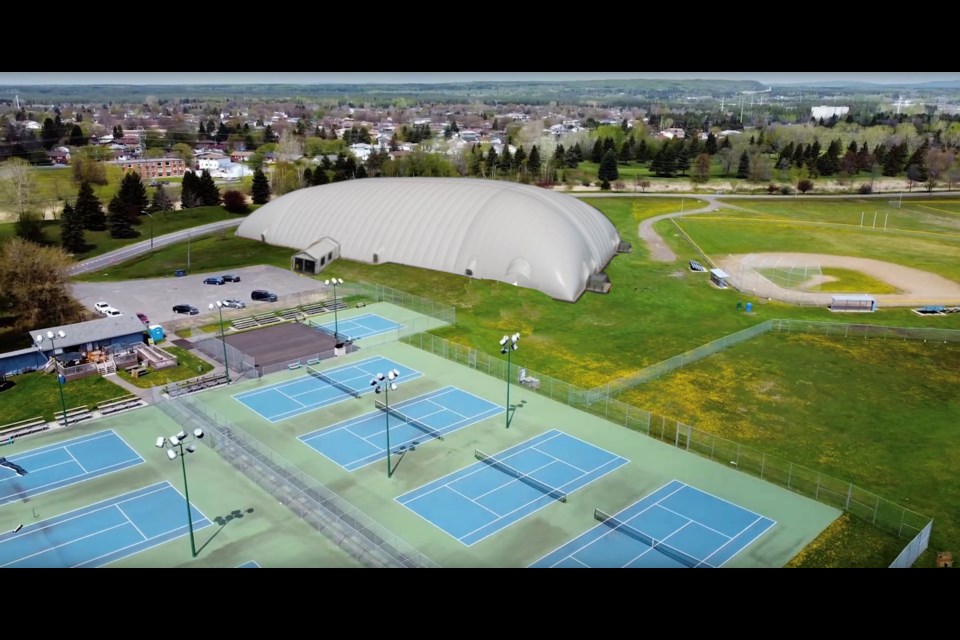THUNDER BAY — The Thunder Bay Community Tennis Centre will seek more city funding to cover rising costs on its planned tennis bubble at Chapples Park.
Project lead Pasi Pinta announced plans to seek support beyond the $1.5 million already committed by the city at a town hall held by at-large city councillors Thursday evening.
The request came even as several tennis centre members at the town hall expressed reservations over the organization’s handling of the project.
Pinta said the centre has secured $3.5 million in funding commitments, but remains about $400,000 short on a build estimated at $3.9 million.
The centre has secured a line of credit to cover the shortfall as it continues to fundraise to make up the difference. It's expected additional funding from the city would help pay off or reduce the amount of that loan.
Pointing to inflation since council committed funds in 2019, Pinta expressed hope the city would up its contribution.
“Four years is a long time, and four years of inflation has done a number on the projections we had,” he said.
Pinta said the group hopes to come before council in the coming weeks to formally make the case for further funding.
The request received a friendly reception from at least two councillors Thursday, but will need to win approval from a council that has been generally skeptical of new spending as it debates service cuts and considers a historically high tax hike in 2024.
“I’d be very open to additional funding… with inflation and whatnot,” said Coun. Mark Bentz. “I view this project as very important, we want it to succeed. We don’t want it to fail based on a small extra contribution.”
“You guys have done a great job of bringing funding to the city, doing a lot of leg work, you provide a great service to the community, so absolutely, I’m pretty sure it would be quite well-received.”
Coun. Rajni Agarwal called a $400,000-increase on a $3.5-million project understandable, given inflation in the construction sector since 2019.
“Between labour costs and material costs, everything’s gone up 10 or 15 per cent,” she said. “So let’s see what we can do to all work together and fill that gap.”
That rhetoric obscured significant cost increases for the project, as the scope evolved, in recent years.
The tennis centre initially estimated costs at $1.8 million when it presented plans to cover existing outdoor courts in 2019. The estimate had risen to $3 million by 2020, after plans evolved to cover some existing courts and build two new ones.
Earlier this year, the centre pegged costs for a facility with six new courts at $3.5 million, before sharing the most recent estimate of $3.9 million.
The centre had hoped to open the bubble this year, but did not conclude negotiations in time with the city for a ground lease, which must be in place before construction begins. Some site preparation and purchasing of equipment has already occurred.
The negotiations continue to drag on, a year and a half after city council gave its blessing in principle for a bubble on city land at Chapples.
The centre now hopes to open the bubble, which will also offer daytime pickleball play, in 2024.
At Thursday’s town hall, several centre members said indoor tennis is badly needed, but raised concerns over the direction of the project.
Longtime member Keltie MacDonald said she's dismayed council endorsed plans for a structure that won't meet the city’s own climate commitments, set out in its net zero strategy.
“I believe with [the city’s] net zero strategy… heating this bubble, which is basically uninsulated, with natural gas is really quite negligent in the time of our [climate] crisis,” she said.
She noted council had voted to follow higher environmental standards for a proposed indoor soccer facility and at other recreation facilities.
“I think we should take a few steps back and see what we can do to ethically sustain it… like you’ve done for the indoor turf facility,” she said.
In an interview, Pinta said the centre had pursued funding for a rigid structure, but had not been successful. He added no rigid tennis structures have been built in Canada over the past 10 to 15 years other than the National Tennis Centre in Toronto.
Pinta also shared a rough analysis indicating the carbon footprint for a steel-supported structure and a bubble would be similar over a 20-year lifetime at roughly 2,200 tons of CO2, thanks to upfront emissions associated with construction materials like steel and concrete.
Members Kristine Thompson and Carly Fuchihara, who previously sat on the centre's board, urged councillors to exercise more oversight over the project.
“We’d like to know what the city’s commitment and responsibility is going to be [after] the $1.5 million is given,” said Thompson.
They described the climate at the centre as challenging, and questioned whether the group has adequate financial and governance controls in place.
“That poses a lot of risk, when we move into a year-round facility like a bubble,” Thompson said. “You’ve got operations that now are going to be in millions of dollars, with a volunteer board that quite honestly doesn’t have any experience running businesses like this. It’s concerning.”
Bentz encouraged the members to bring their concerns forward formally to council.
“There's a lot of taxpayer money there, so we would be interested in that,” he said. “We'd pose the question to administration and ask for their recommendations.”
Tennis centre members voted to take out a $400,000 loan to cover the financing gap at a September meeting.
Developer Silvio Di Gregorio stepped forward with an offer to loan that amount on favourable terms to support the project, agreeing to a maximum 10-year repayment term at six per cent interest.
In addition to the $1.5 million from the city, the centre has raised $500,000 from FedNor, $1 million from the NOHFC, $200,000 from Tennis Canada and Rogers, and over $300,000 from private donors.
